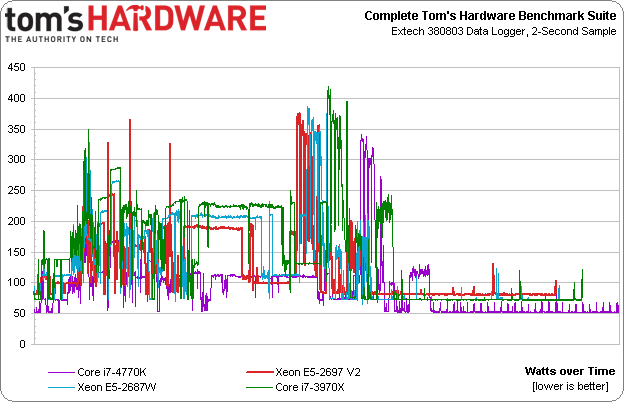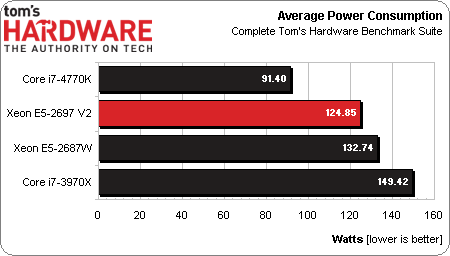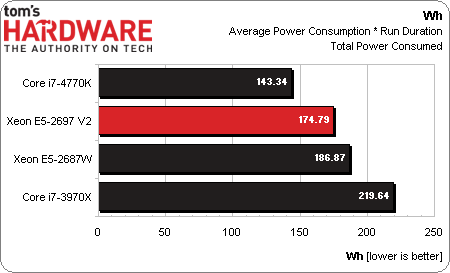Intel's 12-Core Xeon With 30 MB Of L3: The New Mac Pro's CPU?
Power Consumption: Does Ivy Bridge-EP Impress?
The biggest news in my Core i7-4960X preview was that, although Ivy Bridge-E didn’t impress in our benchmarks, it absolutely floored us with its efficiency. After multiplying performance by average power consumption, we discovered that the high-end -4960X was actually more efficient than a Core i7-2700K.
Intel’s upcoming Xeon E5-2697 V2 will also be a 130 W part. But because it sports twice as many cores, we’re expecting its power consumption throughout our suite to be measurably higher (particularly in the threaded tests).
We’re still logging power through the entire Tom’s Hardware benchmark suite every two seconds, and we continue adding a half-hour of idle time to the end of the test, bringing down average power on purpose to better-reflect a real-world usage model. However, I discovered something that required re-running my power data.
SiSoftware Sandra gets run alongside the other benchmarks. This diagnostic’s cache module tests the L1 data and instruction caches with 13 data points for every core. On a six-core processor, that’s 468 tests. On a 12-core processor that’s 936 tests. As a result, this isn’t a faster-is-better benchmark, so it throws off the performance-oriented efficiency result. The solution was to rem out Sandra from the power run and re-run those numbers. Unfortunately, I don’t have the Core i7-4960X anymore, so we have to leave that data point out for now…
None of the CPUs in this comparison can come close to Core i7-4770K’s amazingly-low idle power numbers. In fact, the 12-core Xeon E5 idles pretty high compared to the Core i7-3970X and Xeon E5-2687W. But it’s also the fastest—you can see the red line ending first in our chart.
Sure enough, the Haswell-based Core i7-4770K turns in the lowest average power number. Not surprisingly, the 130 W Xeon E5-2697 V2 follows, with the 150 W Sandy Bridge-EP- and Sandy Bridge-E-based chips behind.
Despite high idle power use, a number of single-threaded benchmarks that penalize it, and lots of artificially-injected idle time that favors the rest of the field, Intel’s upcoming 12-core Xeon E5-2697 V2 turns in the second-best efficiency rating.
Get Tom's Hardware's best news and in-depth reviews, straight to your inbox.
The outcome isn’t as impressive as our look at Ivy Bridge-E. Then again, this page isn’t ever going to favor the most complex hardware configurations. Most exciting is that Intel has a 12-core processor with 30 MB of shared L3 cache that not only works with the previous-generation ecosystem, but also offers more performance than the eight-core Sandy Bridge-EP CPUs it succeeds, while cutting TDP by 20 W. That’s more performance, less power, and, as we can see, better efficiency.
Current page: Power Consumption: Does Ivy Bridge-EP Impress?
Prev Page Results: Media Encoding Next Page Xeon E5-2600 V2: The Real Innovation Happens Up Top-
jimmysmitty Reply11342601 said:The 32-bit build of Geekbench uses x87 code
Typo, top of page two.
Where is the typo? Do you mean the x87? That's not a typo.
This is interesting but not uncommon. The server market needs the boosts while most consumer desktop CPUs are already faster than most software can go.
Of course in 5 years a SB i5 will be no longer relevant but until then it will serve just fine. Even a x58 i7 is still a viable option for a CPU and its been out for at least 4 years. -
vmem Interesting article. Must admit though, while the Mac Pro's performance is certainly impressive, the overall pace of development in the high-end has been rather boring for the past 2 years. can't wait to see what Haswell-E can do late next year.Reply
"Regardless of whether you love or hate the “wastebasket” design, the system’s specs are very impressive for the volume of space it occupies."
And this remark touches on the core of the problem. these are a specialized, niche market of professionals who're buying this uber-expensive desktop for PRODUCTIVITY. sure it should look nice, especially in the office of a professional designer. but must it be SMALL? honestly, build a giant aluminum bookshelf if you have to. make it look elegant and artistic, maybe give people some power to customize it's looks, but ultimately give people the ability to customize the machine and buy the level of productivity they need. Apple, you've done some great things, as well as some things that I don't particularly like. but watching you kill the freedom of the small group of designers who love your products is rather sad... -
Someone Somewhere Reply11342721 said:11342601 said:The 32-bit build of Geekbench uses x87 code
Typo, top of page two.
Where is the typo? Do you mean the x87? That's not a typo.
Hmm, on a quick Wikipedia read, x87 was the instruction set used for the floating point instruction sets in the 8087 and later FP co-processors. Interesting.
Oops... sorry. -
natoco In a years time with the haswell refresh and series 9 chipset it will still make everyone yawn even if it was this year. Everything has been going into mobile since Nehalem. On the bright side, phones and tablets will start slowing down very soon once they too reach the same manufacturing node as enthusiast pc's, since the node determines the power envelope achievable, thus mobile is about to hit the same wall.Reply -
CommentariesAnd More What I expected for the Mac Pro's CPU was a different CPU optimized for the Mac Pro. Would be surprised if the temps of made by this 12Core beast keep things cool. But hey , this isn't final , right ? Lets hope for the best ( and an affordable Mac Pro :) )Reply -
PreferLinux http://www.mouser.com/ProductDetail/Intel/CM8063501288843S-R171/?qs=sGAEpiMZZMvqxsBVy5ZiuowErqth9imUwPY6%2fY0Um1w%3dReply
Guess what?
"Description: CPU - Central Processing Units Xeon E5-2697v2 12 CR 2.7GHz FCLGA2011"
"Pricing (USD)
1: $3,249.19
2: $3,127.04" -
Someone Somewhere Reply11343328 said:What I expected for the Mac Pro's CPU was a different CPU optimized for the Mac Pro. Would be surprised if the temps of made by this 12Core beast keep things cool. But hey , this isn't final , right ? Lets hope for the best ( and an affordable Mac Pro :) )
Nobody optimizes CPUs for anything. The set up costs are ridiculous. The closest you'll get is a custom config, like a chip with (for example) both multi-socket support and overclocking or something, but you'd have to show up to intel with a truck full of cash. -
Duckhunt as usual the folk running intel have become lazy and stupid and the developments in the desktop have gone down the hole. They just add some extra cache and extra threads and then act like they did something.Wow. ( at the stupidity).Reply
Instead of pushing out code or getting the rest of the industry to use more threading applications and develop it to make it more stable and useable. Nothing.
I guess when we have a third world america. You might as well go back to a decade 1368x738 with it being the most popular in 2006. Who can afford it? It the retro push backward.
-
Someone Somewhere Intel can't really do much about forcing the industry to use more threaded apps.Reply
Not their job to write code, other than drivers. They do make x86 Android though, because the drivers are pretty much hardcoded.
Do agree on the 1366x768 though. It's the same number of lines as XGA, just with a few pixels on the side. Maybe Intel should have forced a PPI measurement on Ultrabooks - that might have helped.



